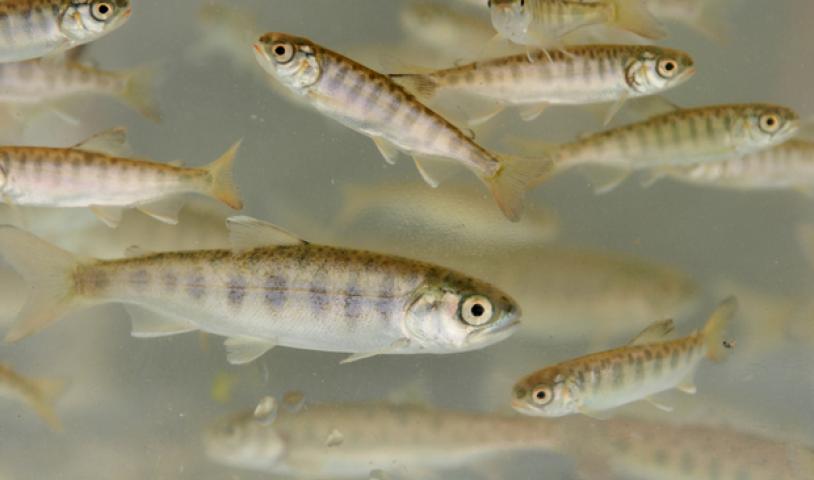Sediment problem halts Tyson power project
Friday, May 14, 2010
Renewable Power Corporation has halted its Tyson Creek power project after sediment slid into Tyson Lake in February, causing turbid (sediment-laden) water to be piped into Tyson Creek, the Tzoonie River and Narrows Inlet. Turbid water can pose a risk to fish and fish habitat.
“The plant may not start up operations again without prior approval from the Ministry [of Environment], which will only be granted if satisfactory revisions are made to operational and monitoring procedures,” according to an email from the Ministry of Environment (MOE). “Those revisions must be sufficient to ensure and allow confirmation that operations are not having an unacceptable impact.”
The project started operating in December, but senior engineer and company co-owner Peter Schober said the company noted a sharp spike in water turbidity in February. On Feb.17, the MOE visited the project to investigate reports of sediment entering Tyson Creek and the Tzoonie River.
“They talked to us and we voluntarily cut back [operations],” Schober said.
At the time, he said, it was still very cold, and shutting down the operation entirely would have risked the penstock — or pipe — from freezing. Because of that, the company instead slowed operations to a minimum output level, generating only a small amount of power.
An investigation by MOE and the Department of Fisheries and Oceans (DFO) revealed the turbidity spike was caused when sediment slid into Tyson Lake, which feeds the project. DFO habitat biologist Al Magnan said project operations, which draw down the lake level, caused erosion of a lake delta and resulted in the sediment entering the lake.
Schober said since February, Renewable has been working with MOE and DFO to address the turbidity situation and create systems to better address any future turbidity problems.
“We’ve ramped up the amount of monitoring we have to do,” he said. “We needed an automatic shutdown when the turbidity comes high, so that has been installed.”
But in Tyson Lake, Schober said the sediment was still in the water. The heavier part of it had settled into the lake bottom, but a fine glacial flour clay was still suspended in the water.
On March 20, Schober said, working with regulators and consultants, the company released a volume of turbid water from Tyson Lake as part of a test; they needed to find out if the sediment would settle out naturally from the water and if it would cause any environmental impacts as it flowed into Tyson Creek, the Tzoonie and Narrows Inlet.
“Our fisheries biologist, DFO and the MOE wanted to determine if there were any harmful effects,” Schober said. “I mean the water’s still there, it has to come out.”
The Sunshine Coast Conser-vation Association (SCCA) reported a number of March 21 observer accounts of a plume of turquoise-coloured water that extended from the Tzoonie River estuary and extended approximately one kilometre down Narrows Inlet.
SCCA executive director Dan Bouman said the association is concerned about what impacts the turbid water could have had on spawning fish in the Tzoonie River.
“By mobilizing these sediments, they end up getting flushed through the Tzoonie River, and in concentrations, these materials are harmful to fish,” Bouman said. “Silt can smother fish eggs, that’s the first thing, and extremely fine silt can cause the gills of salmon fry to become glued together, which suffocates the fish.”
But Magnan said their investigation has shown the release of turbid water has not had much of an impact on the environment.
“What we’re finding is that it looked really bad from the air, but once you actually got on the ground and took some measurements, it actually wasn’t as bad as it looked,” Magnan said.
He said all the heavier gravel that originally slid into Tyson Lake settled out in the lake itself and hasn’t affected downstream fish habitat. Beyond that, DFO’s investigation revealed the fine clay floating on the water surface — which has the potential to block out sunlight and stop algae productivity — had little impact.
Bouman said in the SCCA’s view, Renewable’s releases of turbid water contravened the Fisheries Act.
But Magnan said this isn’t the case, and DFO is not considering laying any charges at this point against Renewable under the Act.
“We’re still monitoring the situation,” he said. “They are still shut down, so now we’re just trying to find a resolution with the Ministry of the Environment as to how we can start up operations again and make sure we don’t impact any fish or fish habitat.”
Bouman said he’s also concerned that regulators didn’t correctly anticipate turbidity risks when the project was approved, and they could be making similar errors elsewhere in the province.
“There was no adequate environmental assessment of the potential for sediment mobilization in the lake before the project was approved,” he said. “It’s far more serious than the loss of all the fish in any given stream because it could affect streams all over the province.”
As for the Tyson project, Schober said, as of late March, when temperatures rose enough to reduce the risk of the penstock freezing, the project ceased operating and is producing no power. As it waits for the regulatory bodies to give it the go ahead to start operating again, the company finds itself in the ironic position of having to pay for its own power.
“If this hadn’t happened, we would be really excited about this,” he said, explaining that the project is the biggest “head” plant in North America, meaning that there’s the longest drop between the lake and the base of the project, which allows for particularly efficient power generation.
“But it’s the right thing to do: shut it down, make sure that every last thing has been examined and every possibility has been gone through, and it just takes a long time to do.”





